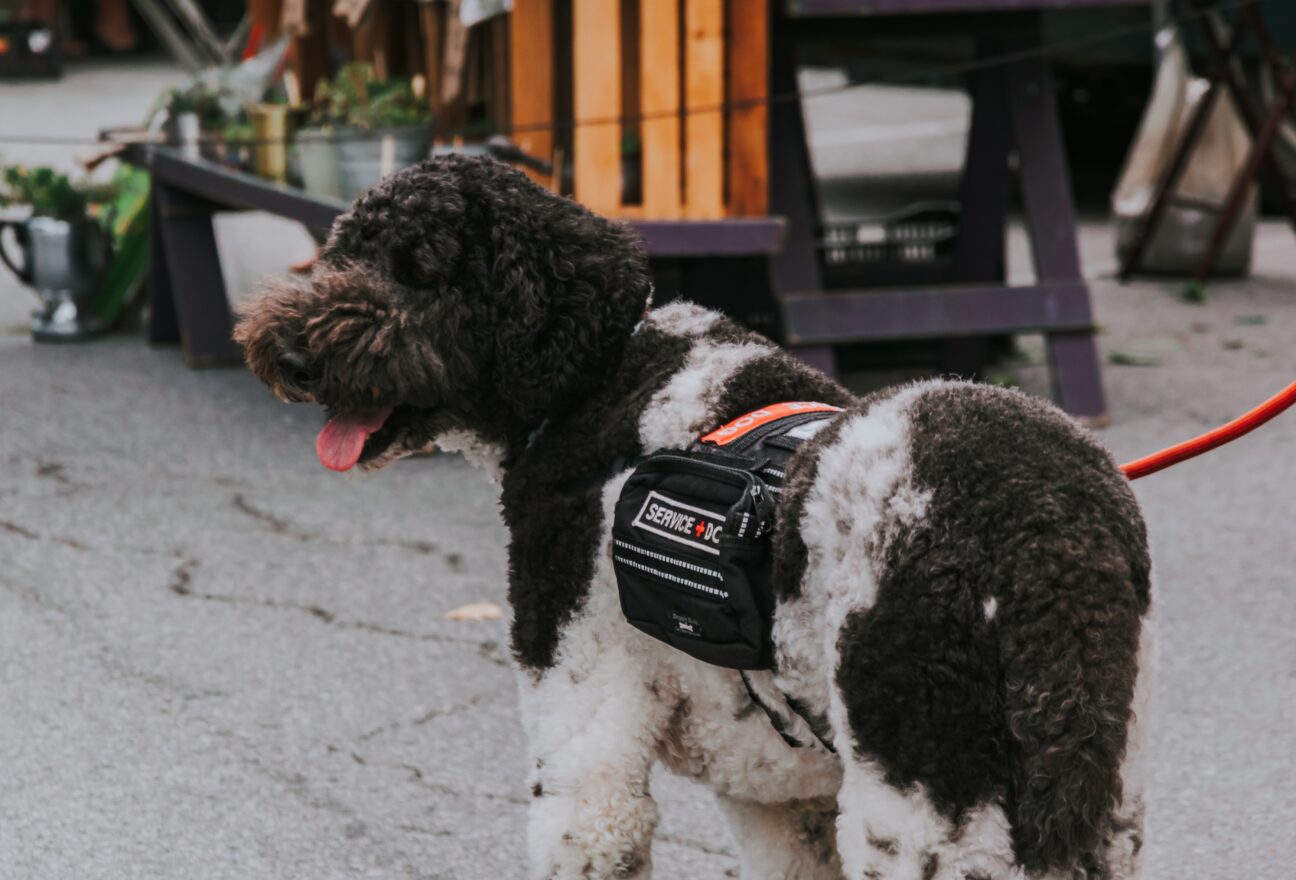The Healing Power of Dogs: Therapy and Service Dogs for Children with Disabilities
Dogs have been loyal companions to humans for centuries, but their value extends far beyond mere companionship. Dogs have an innate ability to sense our emotions and provide us with comfort and support, making them ideal candidates for therapy and service animals. For children with disabilities, in particular, therapy and service dogs can provide a unique source of emotional, social, and physical support.
Therapy Dogs: Unconditional Love and Comfort
Therapy dogs are specially trained to provide comfort, affection, and companionship to people in need. They visit hospitals, nursing homes, schools, and other facilities to offer their services to those who need it most.
For children with disabilities such as autism or ADHD, therapy dogs can help reduce anxiety levels by promoting calmness through touch. One of the most significant benefits of therapy dogs is their ability to offer unconditional love.
Many children with disabilities struggle with feelings of isolation or loneliness due to the challenges they face in everyday life. A therapy dog’s unwavering affection can help them feel accepted despite their differences.
Service Dogs: More Than Just a Companion
Service dogs are specifically trained to perform tasks that aid individuals with disabilities in carrying out everyday activities that may otherwise be difficult or impossible without assistance. For children with mobility issues or medical conditions such as diabetes or epilepsy, service dogs can make all the difference.
Service dogs can be trained to pull wheelchairs or assist in walking for those who have difficulty getting around on their own. They can also be trained to sense changes in blood sugar levels or detect an oncoming seizure before it happens, providing invaluable medical alert services.
Both therapy and service dogs play important roles in supporting children with disabilities physically and emotionally. While they serve different purposes – one offering comfort while the other providing essential aid – they share the ability to form strong bonds with their human companions and improve their quality of life.
Therapy Dogs
Therapy dogs are specially trained to provide emotional support to people in a variety of environments, including hospitals, nursing homes, schools and other public places. They are different from service dogs because they do not perform specific tasks for individuals with disabilities. Instead, therapy dogs work with handlers to provide comfort and companionship.
These furry friends can be a great source of support for children with disabilities. Therapy dogs have been known to help reduce anxiety and stress levels as well as increase feelings of calmness and relaxation.
In addition, therapy dogs provide socialization opportunities that may be difficult for children with disabilities to experience otherwise. There are many organizations across the country that offer therapy dog programs specifically designed for children with disabilities.
For example, the nonprofit organization Canine Companions for Independence offers a program called “Tails of Valor” which pairs wounded veterans and their families with therapy dogs. Another nonprofit organization called Intermountain Therapy Animals provides pet therapy services in hospitals, schools and other facilities across the United States.
Service Dogs: The Ultimate Support System for Children with Disabilities
Service dogs are specifically trained to provide assistance and support to individuals with disabilities. These dogs are highly skilled and have undergone extensive training to perform a variety of tasks that help people with disabilities live more independent lives. Service dogs can be further categorized into various types depending on the type of disability they are trained to support, such as mobility assistance, medical alert, seizure response or psychiatric service.
One of the most important roles service dogs play is in supporting children with disabilities. For example, children who experience mobility challenges may require a dog that can help them move around or pick up objects that they cannot reach by themselves.
Service dogs can also be trained to assist children who require constant monitoring due to various medical conditions such as diabetes. These specially-trained animals can detect low blood sugar levels and alert their handlers to take necessary action.
Various organizations across the country provide service dog programs for children with disabilities. One such program is “4 Paws for Ability,” which trains service dogs for children with different types of special needs including autism spectrum disorder, hearing impairment, and seizure disorders.
This organization provides emotional and physical support services for families who need assistance in obtaining a service dog as well as training them on how the animal will work best for their child’s needs. Service dogs play an essential role in supporting children with disabilities by providing them with trained assistance in their day-to-day life activities.
They provide not just physical support but also emotional comfort and companionship which can make a world of difference in the lives of these children. In addition, there are many organizations that offer specially-designed programs to train these animals for different types of special needs so that families who need assistance in obtaining a service dog have access to necessary resources.
Differences between Therapy Dogs and Service Dogs
Distinctions in Training, Certification, and Legal Rights
One of the primary differences between therapy dogs and service dogs are the requirements for training, certification, and legal rights. Therapy dogs typically require less formal training than service dogs.
They must be well-behaved, socialized, and trained to provide emotional support to individuals. In contrast, service dogs require extensive training that includes learning specific tasks to assist their handler with their disability.
These tasks can include opening doors or retrieving items for individuals with mobility impairments or sensing medical emergencies for individuals with conditions like diabetes. In terms of certification, therapy dogs do not have any formal legal recognition like service animals do.
Service animals are covered under the Americans with Disabilities Act (ADA) which provides certain legal protections to their handlers such as access to public places like schools or restaurants that may otherwise prohibit pets. The ADA also requires businesses to make reasonable accommodations for service animals including allowing them inside establishments regardless of any no-pet policies.
Factors to Consider when Choosing Between a Therapy Dog or a Service Dog for a Child with a Disability
When deciding whether a therapy dog or service dog is more appropriate for supporting a child with disabilities there are several factors that should be considered. Firstly, what kind of assistance does the child need?
If the child needs physical assistance such as mobility support then a service dog would be more appropriate than a therapy dog who primarily provides emotional support. Another factor to consider is the cost associated with obtaining either type of animal as well as ongoing care costs which can include food and veterinary bills.
Service dogs are typically more expensive due to their extensive training while therapy dogs may have lower up-front costs but still require ongoing care expenses. It’s important to consider the child’s level of comfort around animals and any potential allergies they may have.
Allergies or fear of dogs can make it difficult for a child to benefit from either type of animal. Careful consideration must be taken to ensure that bringing a therapy or service dog into a child’s life is appropriate and will not cause any harm.
While both therapy dogs and service dogs can provide invaluable support to children with disabilities, there are important distinctions in their training, certification, legal rights, and cost which must be considered when choosing which type of animal is appropriate. Ultimately, the decision should be based on the specific needs of the individual child and their ability to benefit from the therapy or support provided by the animal.
Benefits of Therapy Dogs vs. Service Dogs
Therapy dogs and service dogs both provide invaluable assistance to children with disabilities, but they differ in their training, certification, and legal rights. Depending on the needs of the child and their family, one type of dog may be more beneficial than the other. Here we will explore some advantages of using a therapy dog over a service dog for certain needs, as well as some advantages of using a service dog over a therapy dog.
Advantages of Using a Therapy Dog Over a Service Dog for Certain Needs
One advantage of using a therapy dog over a service dog is that therapy dogs are typically more accessible and less expensive. Whereas service dogs require extensive training to learn specific tasks, therapy dogs undergo basic obedience training and are socialized to interact with people in different environments.
This means that therapy dogs can be used in various settings such as schools or hospitals to provide support to children with disabilities who may need emotional comfort or socialization help. Another advantage is that therapy dogs can often be used on an as-needed basis without requiring constant care from their handler.
While service dogs need consistent care from their handler due to their specialized tasks such as guiding individuals with visual impairments or alerting those with medical conditions, therapy dogs can simply provide comfort by being present during challenging situations. It’s important to note that many families find having a furry companion comforting in itself; Therapy animals have been shown through research studies that they reduce stress levels and anxiety which is especially beneficial for children living with disabilities.
Advantages of Using a Service Dog Over a Therapy Dog for Certain Needs
One key advantage of using a service dog over a therapy dog is that they are trained to perform very specific tasks tailored towards an individual’s unique needs and circumstances. For example, if the child has mobility issues then they can utilize mobility support from a service dog, which may include guiding them in public, fetching objects they cannot reach, or even opening doors.
Another advantage is that service animals have greater legal protection than therapy dogs. The Americans with Disabilities Act (ADA) defines service animals as dogs trained to perform specific tasks for individuals with disabilities and grants them access to public places such as restaurants, airports and hotels.
Whereas Therapy dogs do not have federal protection under the ADA and therefore are treated differently depending on state laws or private business policies. A service dog can provide a sense of independence for the child as they are trained to fulfill their specific needs without requiring constant direction from their handler.
This gives children with disabilities more freedom to navigate public spaces confidently. Both therapy dogs and service dogs can provide incredible benefits to children with disabilities in different ways.
It’s important for families to carefully consider their individual needs when deciding which type of dog is right for them. Ultimately it’s essential that the bond between dog and individual is established before making any commitments because these furry companions eventually become part of the family providing emotional support beyond what verbal language can express.
Challenges in Obtaining Therapy or Service Dog Assistance
Financial Considerations
While therapy and service dogs can be life-changing for children with disabilities, the costs associated with obtaining one can be significant. Training and caring for a dog requires a considerable investment of time, money, and resources.
According to the Assistance Dogs International (ADI), the average cost of training and placing a service dog is between $20,000 to $60,000. This cost includes breeding, raising, and training the dog as well as pairing them with their human partner.
Additionally, therapy dogs may not be covered by insurance policies because they are not considered medical equipment. This means that families must bear all expenses out of pocket or seek alternative ways to fundraise for their animal companions.
Legal Barriers to Accessing Trained Animals
Another challenge faced by families seeking therapy or service dogs is navigating the legal barriers that exist in many regions. Laws governing access to trained animals vary widely depending on location and type of assistance animal sought. Some states require mandatory certification or licensure while others do not have any regulation at all.
Moreover, some landlords may refuse to allow pets on their property even if they are service animals due to personal belief systems or lack of understanding about disability laws. In addition to facing legal challenges when accessing trained animals for children with disabilities, potential handlers must also contend with scams by unscrupulous vendors who prey on unsuspecting families desperate to obtain these specialized animals.
Coping Strategies
Despite these barriers that exist when seeking assistance from trained therapy or service dogs for children with disabilities there are things parents can do. One option is contacting national organizations that offer financial assistance such as fundraising campaigns through social media platforms like GoFundMe.
Working closely with an experienced attorney who specializes in disability law can also help navigate complicated legal issues surrounding access to trained animals. Additionally, conducting thorough research on potential vendors before signing any contracts can reduce the risk of falling prey to scams.
While there are challenges that exist when seeking assistance from trained therapy or service dogs for children with disabilities, families should not be deterred. By working closely with experienced professionals and conducting thorough research, children with disabilities can gain access to the life-changing benefits that come with having an animal companion by their side.
Conclusion
Therapy and service dogs can be valuable resources for children with disabilities. They provide much-needed support such as emotional comfort, socialization, mobility assistance, and medical alert services. Both types of dogs can have an immeasurable impact on the lives of children with disabilities and their families by improving their overall quality of life.
Despite their differences in training, certification, and legal rights, both therapy dogs and service dogs play important roles in supporting children with disabilities. Therapy dogs can provide a sense of calmness and comfort to children who struggle with anxiety or depression.
They can also help improve social skills by providing opportunities for interaction and communication. Service dogs are trained to perform specific tasks that support a child’s safety or mobility.
They offer independence to children who face physical limitations or health challenges. However, obtaining a therapy or service dog can be challenging due to financial considerations as well as legal barriers that may limit access to trained animals.
These obstacles make it difficult for some families to receive the assistance they need from a furry friend. Overall, the benefits of using therapy and service dogs for children with disabilities cannot be overstated.
These animals can help provide companionship, comfort, safety, and independence which is essential for living a fulfilling life despite any limitations caused by disability. By improving the lives of these special kids one paw at a time we create communities where everyone is embraced and valued equally!






